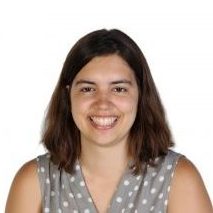EMBL School Ambassador Mariana R. P. Alves
Country: Portugal
Profile
I’m Mariana and I was born in Coimbra, Portugal, where I studied Biochemistry. I went on to study Cellular and Molecular Biology in Cambridge (UK) and Copenhagen (DK), before joining EMBL for my PhD.
It’s fascinating how animals evolve from a single cell to a complex embryo, but many of the mechanisms at play are yet to be understood in detail. I work in the Crocker lab where we use the fruit fly as a model and follow the motto “seeing is believing”, using imaging techniques to understand how a single cell evolves into an embryo. Specifically, I want to understand the mechanisms underlying how the spatiotemporal activity of enhancers (regions bound by transcription factors that promote or repress gene expression) is regulated and contributes to complex gene expression patterns during development.
I believe everyone should be an EMBL School Ambassador, and visit and inspire their old schools. When you look back, would you think you would work at EMBL one day? How would you have liked to have a visit from a scientist there?
When I was studying Biochemistry at the university, I founded with some colleagues and a Professor the MiniBioqs Project, which took simple chemistry experiments to ill kids in the paediatric hospital. Since then, I have embarked on varied science communication endeavors, from radio broadcasting and podcasting, to fundraising or art & science projects. It was with ELLs that I have focused more on how to share my own research with schools and it has been a great time volunteering for their activities, including the EMBL School Ambassador programme. I am also a volunteer for Native Scientist, which is a project to foster scientific literacy and heritage language to migrant pupils. Sometimes language can be a barrier, so I did a few translations of scientific resources for schools, and think it is a great area to invest as well. If we all took a bit of our time to translate good content, science outreach would reach so many more kids. The future of society really lies in young people and, in my opinion, there is no better tool to change the world than to providing pupils with evidence based education for turning them into better citizens.
So what are you waiting for to become an EMBL School Ambassador at EMBL?
Read about my experiences in the diaries!
Diary 1
Visit to High School José Falcão, Portugal
Coimbra, 29th April 2019
I was more than thrilled when the opportunity came to participate in the EMBL School Ambassador Programme, and to go to my old high school to show students what it is like to work in life sciences and at EMBL. When I was a student there, I didn’t even dream of working at a fantastic place like our institute, and I was excited to show the students that if I can, they could too! I want to thank Professora Paula Paiva for coordinating my visit so smoothly.
Interestingly, when I was studying there I was not sure if I wanted to be a scientist, I had a wide spectrum of possibilities in my mind, including literature or journalism, before I decided for my BSc in Biochemistry. When I searched for pictures of my old class and time there, I couldn’t find any pictures related with classes, just photos of when I was the DJ at the high school parties, of campaigns for the students’ association and obviously of the prom. I wanted to give the students an overview of what led me to EMBL, show them super exciting videos of how we can now see what was before invisible (like DNA and RNA), and remind them about why fundamental research and evidence based decisions are important.
There were 62 students in total. When I arrived at the amphitheatre I remembered being there as a teenager, and it was quite an interesting perspective I acquired… I never thought I would be back to give a lecture, I felt really good. The students knew about DNA, RNA and transcription factors, which was great, so that I could show them videos of live embryos where you can see these molecules and explain what we learn with these studies. When I was their age, I only learned about these molecules in cartoons, and I am very passionate to try to see them live in my daily work and wanted to transmit this excitement to them.
I gave them questionnaires before and after the lecture, and was very pleased to read that some of them were reassured about their idea of studying sciences, and that they felt this class was relevant for their future. One student even said that since they learned from my EMBL’s example that labs can be composed of many nationalities, they were more attracted to being a scientist. Science can also make the world more tolerant! You can see more from the questionnaires by clicking below:
Furthermore, there was an unexpected lesson from these questionnaires:
When we do science communication, we try to teach and inform about what we research (which is relevant for any citizen to make fact based decisions) and we also try to inspire young people to do science. I was so caught up with preparing this presentation that I only remembered the part about inspiring them to be scientists. I naively thought that the success of my visit could be measured by the number of young minds who I convinced to be researchers. I was very fond to realize that for many of those who are not thinking of pursuing a scientific career, they still thought the lecture was relevant for their future and they appreciated what they learned. It was a great lesson because it reminded me that communicating what we do is important for every citizen to be informed and make better decisions.
I was lucky with the timing as well, as I got to celebrate my grandma’s 96th birthday after the school visit. It is not every day that one turns 96.
I would like to thank Professoras Paula Paiva and Eunice Carvalho who hosted me and the other two biology professors present who took their classes and had enthusiastic questions. I would also like to thank Rafael, Pechincha, Ana and Gilberto for helping me analyse the 120 questionnaires who were answered by hand. Also to the ELLS team for being so helpful and kind and to the EMBL communications department for preparing EMBL souvenirs for the students.
I hope to repeat this fantastic experience and recommend it to everyone!
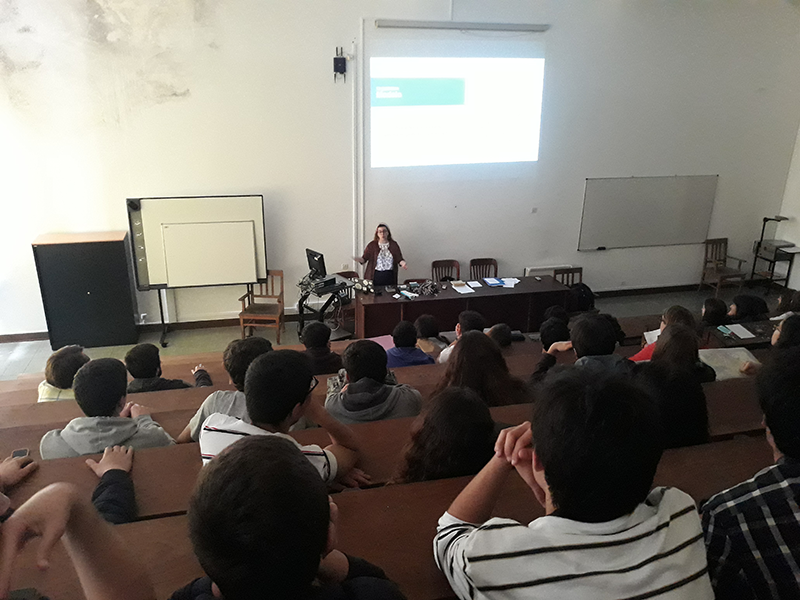
Diary 2
Visit to primary school and high school Ibadan, Nigeria
Ibadan, 27th & 28th February 2020
For this diary we fly to Ibadan, Nigeria.
This is the first EMBL School Ambassador visit in Africa. For our EMBL PhD symposium in 2018, we invited Prof. Amos Abolaji from the University of Ibadan to give a talk about how he established the first Drosophila lab in Nigeria, and this year he invited me to be a trainer at a workshop he was organizing, and to visit and train his lab too. I asked him then if we could visit some schools and he was thrilled, it would be the perfect opportunity to also train his lab on this sort of visits, and that is how these two visits came about.
I flew with a big suitcase full of educational material which ELLS and the EMBL communications department generously donated (thanks Eva and Verena!), and visited two schools – a primary school, Kingdom Heritage Model School and a high-school, All Souls Highschool.
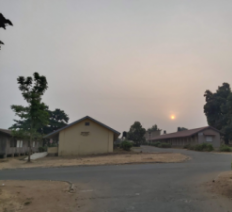
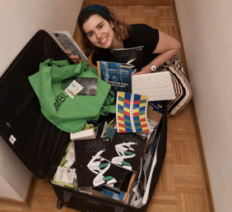
The preparation


We had fun in the lab preparing the different materials for the activities, and deciding how we were going to organize it. For some of the Abolaji lab members, the main lesson they got from this experience was that it was good to plan! We also prepared a feedback sheet for these visits and for that I used a template that I knew from Native Scientist. During my visit, I was interested to notice how every time I had to figure something new out there was a diversity of sources I could recall tools from. For me this emphasises the hidden skills you can gain when you least expect – therefore, we should really follow our passions instead of strategizing skill building.
First visit – Kingdom Heritage Model School
For this visit we had ~60 pupils (9 & 10 years old) in 3 groups (one in each classroom) and then we rotated. In one class, they learned about the fly and got to see it under the microscope. In another room, they learned about the cell and built its components with plasticine. In the third group, we asked them to draw a scientist and talked about how science is global and made for sharing. At the end, we gave them EMBL gummy bears and postcards as a treat. The kids were beyond happy and we even got audio-visual coverage – this was the first school outreach for this type of school and they wanted to show the other schools of the same group the success that it was. Some of the pupils gave us lovely notes and all of them were asking us to come back the next day. From the feedback sheet we know that for most of them this was the first time meeting scientists and they all learned new things.
Second visit – All Souls High School
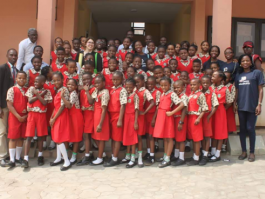
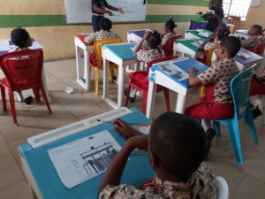
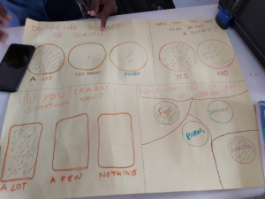
At All Souls we had 60 students between 11-16 years old. Instead of classrooms, we gathered in their hall, which is actually the cathedral of the school. We divided them in 3 groups, maintaining the fly station. Then, we had a group that learned about DNA – using the ELLS Artificial Ribosome Game and Alex Bateman’s DNA origami. The third station was once again about the global aspect of science: the start of an EMBL-Nigeria Pen Pal Exchange. This group of students were shyer but from their feedback we learned that they enjoyed and learned new things.
EMBL – Nigeria Pen Pal
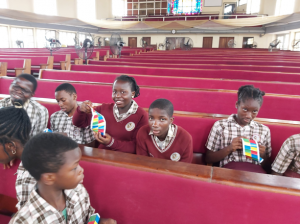
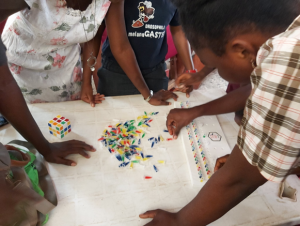
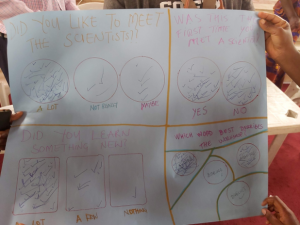
I told the students where I came from and about EMBL and I asked them to write any questions they had for my colleagues, that I would make sure they will answer them back. All of this in real letters, snail mail. I brought back to Germany 60 EMBL postcards with the students’ questions which are incredibly diverse (from science fiction to puberty to culture to religion to coronavirus-related remarks). This activity is inspired by the program Letters to a Pre-Scientist and it was my colleague Rafael Galupa, postdoc in the Crocker Lab, who had the idea that I would integrate it in my visit. We will be writing more about this activity soon – stay tuned! They were all precious but I have to share the message of one of the students – see the postcard below.

In both visits, I made sure to leave more material for the teachers that they can continue to use in the future. In both schools they were very enthusiastic about the impact of these visits, which made us really happy. Some extra material will also be used by the Abolaji lab to take to even more schools in Nigeria.
It was incredible to share this experience with the Abolaji lab members. Here is some of their feedback:
“It was a really interesting time to know about several teaching methods that could catch the students’ attention. Especially the DNA model. The gifts for the students, letters to the researchers, and every aspect of the visit was unique.”
“It added a lot of value to our lab to learn how to be accessible to kids, particularly with pictorial images.”
“The school outreach program immensely helped to imbibe the love of science and research into children right from their tender age, it also stimulated their inquisitiveness toward research. These children raised some ideas that might not have been possible without this program. Quoting one of them, when been taught on how D. melanogaster can be used as a model to study malaria, they asked “How do you check for it’s temperature?”.”
It was a great experience that I will never forget! I would like to acknowledge too the support of the DrosAfrica Trust, who sponsored my trip.
